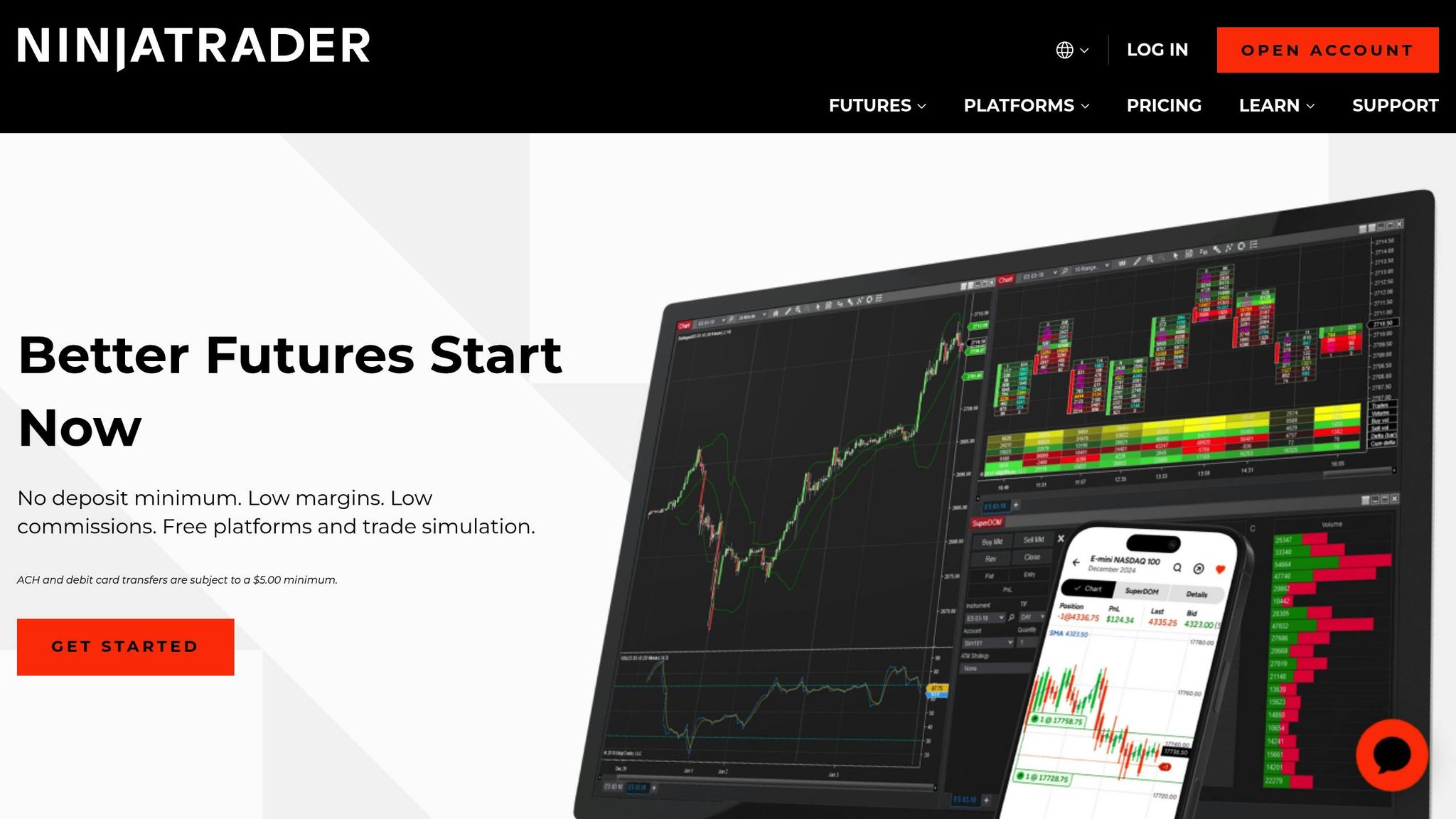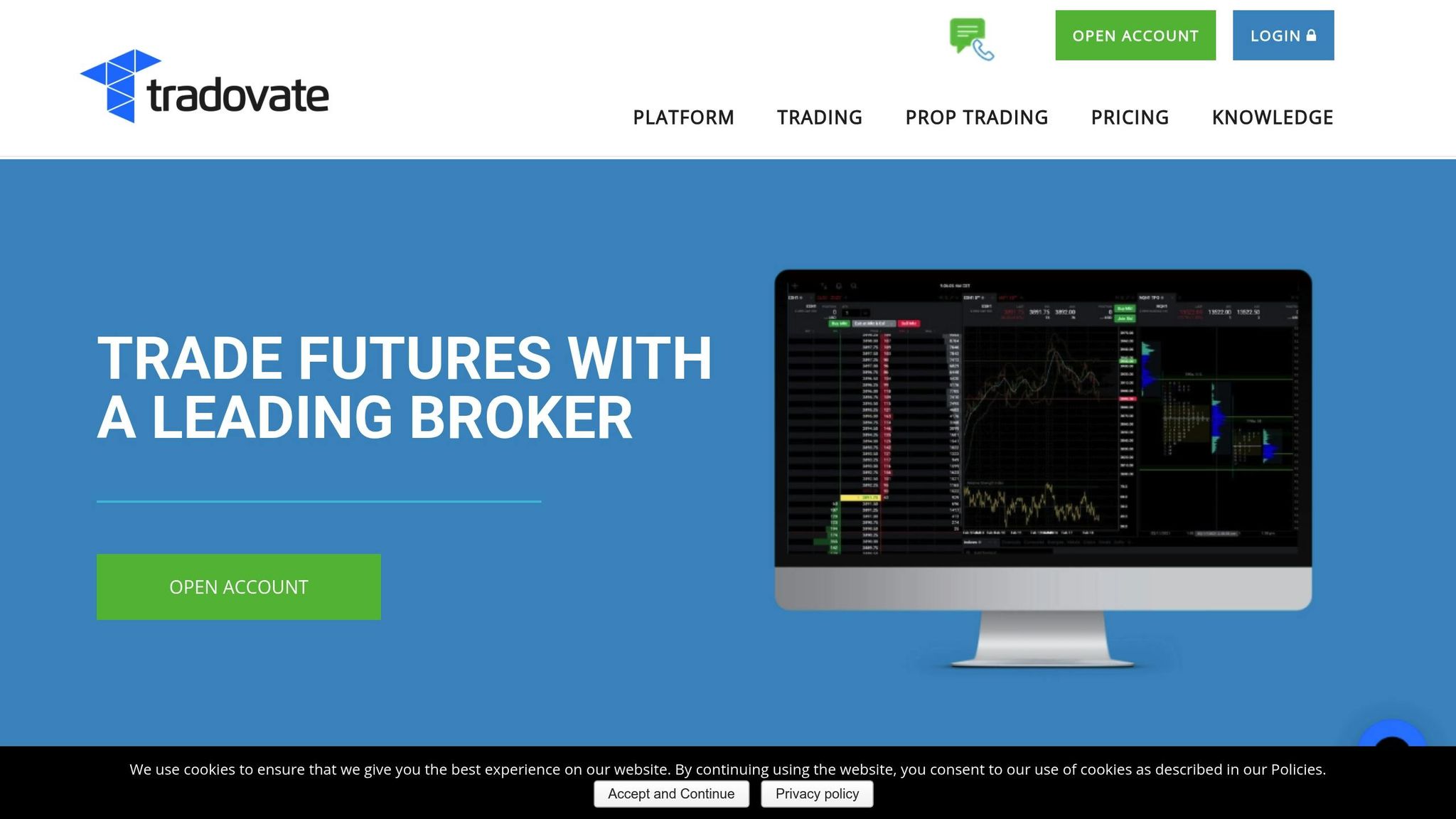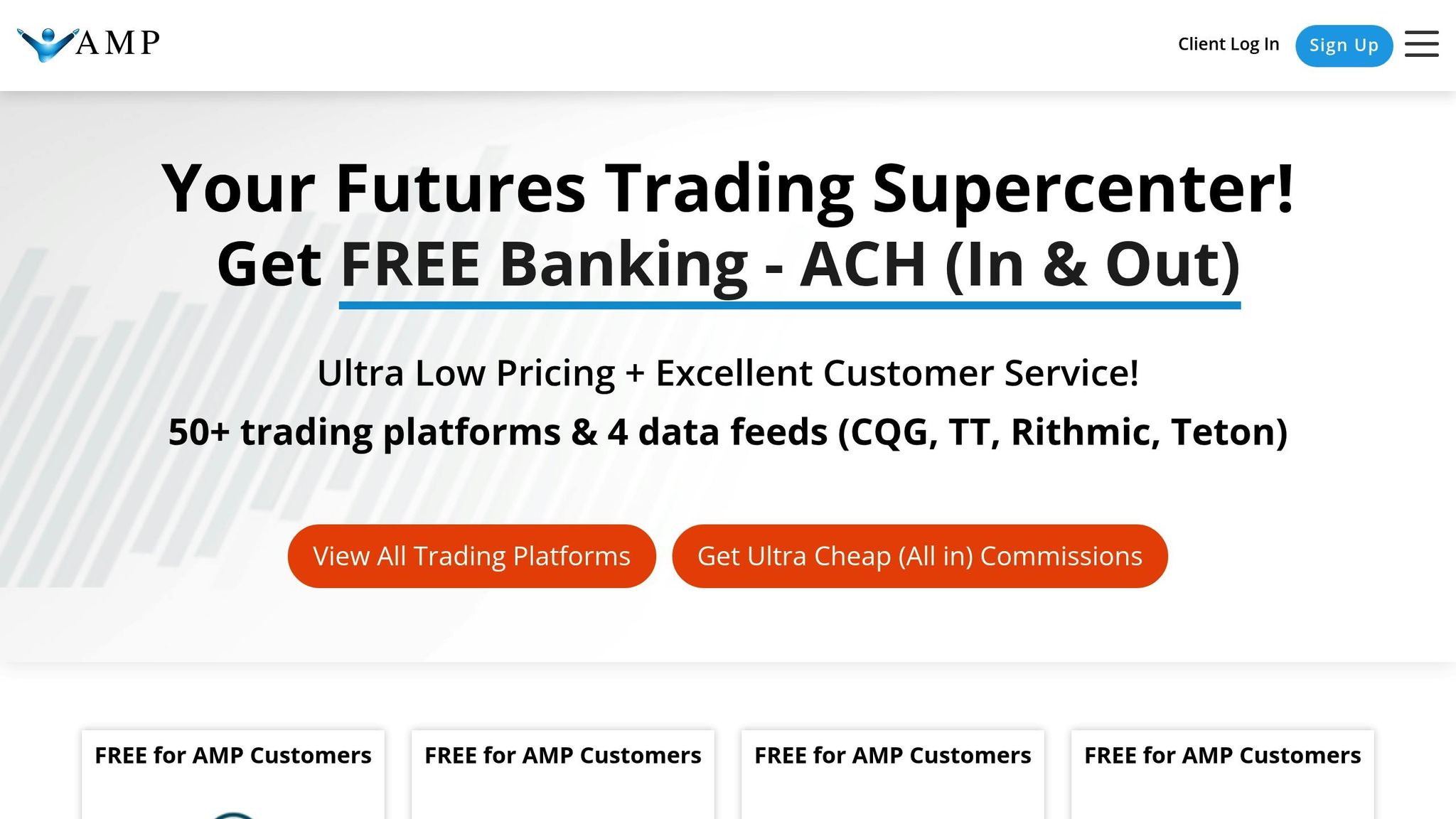When trading futures, saving on fees can significantly impact your profits. This guide reviews four platforms – NinjaTrader, Tradovate, AMP Futures, and TradeStation – focusing on costs, account requirements, and features to help you find the right fit.
- NinjaTrader: Offers flexible pricing with three plans. Contracts start at $0.35 per side, with lower rates for paid plans. No account minimums; margin starts at $50. Advanced tools but extra fees for live market data.
- Tradovate: Web-based, low-cost platform with a simple interface. Fee details require direct consultation, but it’s beginner-friendly.
- AMP Futures: Low $100 account minimum and competitive fees. Ideal for small-scale trading but additional data fees may apply.
- TradeStation: Charges $1.50 for standard futures and $0.50 for micro futures. No account minimums, fast execution, and advanced tools for professionals.
Quick Comparison
| Platform | Per-Contract Fee | Account Minimum | Key Features | Hidden Costs |
|---|---|---|---|---|
| NinjaTrader | $0.35–$1.29 | $0 | Advanced tools, customizable plans | Market data fees |
| Tradovate | Varies | Not disclosed | Simple, web-based design | Requires detailed review |
| AMP Futures | Low fees | $100 | Multiple software options | Data fees may apply |
| TradeStation | $0.50–$1.50 | $0 | Fast execution, pro tools | Exchange/NFA fees |
Choose based on your trading style, budget, and need for advanced tools. NinjaTrader is ideal for active traders, Tradovate for simplicity, AMP Futures for affordability, and TradeStation for professionals.
Best Futures Trading Platforms | My Top 3 For Day Traders
1. NinjaTrader

NinjaTrader offers a pricing structure designed to accommodate traders with varying levels of activity and experience. Unlike brokers that stick to a single commission model, NinjaTrader provides three pricing options tailored to different trading needs.
Fee Structure
NinjaTrader’s three-tier commission system gives traders flexibility in managing costs. Here’s how it breaks down:
- Free Plan: Charges $0.35 per side for micro futures contracts and $1.29 for standard contracts, with no monthly platform fees.
- Monthly Plan ($99/month): Reduces rates to $0.25 for micro contracts and $0.99 for standard contracts.
- Lifetime License ($1,499): Offers the lowest rates at $0.09 for micro contracts and $0.59 for standard contracts.
For example, trading 1,000 micro contracts per month would cost $350 on the free plan, but only $90 with the lifetime license.
When trading US micro e-mini stock index futures, the total cost – including exchange fees – comes to about $3.50 per side. This places NinjaTrader in the mid-range of commission costs compared to other platforms.
Account Minimums
NinjaTrader makes it easy to get started with minimal financial commitment. There’s no required account deposit, and the margin to begin trading is just $50. Intraday margins start at $50 for equity index e-mini futures and $500 for standard futures contracts. This low barrier allows traders to manage larger positions with less upfront capital.
Platform Features
The NinjaTrader desktop platform is packed with tools that cater to both new and experienced traders. Even on the free plan, users gain access to professional-grade charting and analysis tools without additional software fees. The platform also supports advanced order types, algorithmic trading, and comprehensive backtesting features. For those wanting to refine their skills, the simulated trading environment lets users practice with real market data and full platform functionality before committing actual funds.
Hidden Costs
While NinjaTrader offers a lot, traders should be aware of some additional expenses. Mandatory exchange, clearing, and NFA fees apply to all pricing plans. Live futures quotes require a separate market data subscription, which costs $50–$200 per month, depending on the instruments traded. Additionally, other service fees – such as those for wire transfers, account maintenance, or premium support – can add up over time. Delayed market data, however, is available at no extra cost.
2. Tradovate

Tradovate is a web-based platform designed for futures trading, accessible directly through your browser. While specific details about fees, account requirements, and platform features aren’t outlined here, it’s best to visit Tradovate’s official website for the most accurate and up-to-date information. Unlike some platforms that provide transparent fee breakdowns, Tradovate emphasizes the importance of consulting their resources for clarity.
3. AMP Futures

AMP Futures stands out in the futures trading space by combining competitive transaction fees with access to various data feeds and trading platforms. This platform is particularly appealing to traders focused on low-cost futures trading, especially in the commodities markets.
Fee Structure
AMP Futures is known for its low transaction fees, making it a popular choice for active futures traders. One major advantage is the absence of a monthly platform fee, allowing traders to allocate more of their funds directly to trading rather than platform maintenance costs. However, it’s worth noting that the service fees can be on the higher side, which might affect cost-effectiveness depending on trading volume and needs.
Account Minimums
To open an account with AMP Futures, traders need to deposit a minimum of $100. While this low entry point might attract beginners, it comes with limitations. With such a small deposit, traders are generally restricted to trading micro contracts due to margin requirements. Additionally, the inherent volatility of futures markets increases the likelihood of significant losses when starting with minimal capital.
Interestingly, some other low-cost futures brokers have no minimum deposit requirement, making AMP Futures’ $100 minimum slightly less competitive in this regard. Traders should also account for additional costs, such as data and exchange fees, which can add up depending on the trading setup.
Hidden Costs
While AMP Futures provides some free data feeds, more comprehensive options come at an extra charge. For traders who rely heavily on detailed market data, these additional fees should be factored into the overall trading budget. Standard exchange fees also apply, further contributing to the total cost of trading.
Despite these considerations, AMP Futures has earned a Futures score of 4.3/5, reflecting its strong capabilities in futures trading. The platform excels in offering low transaction fees and robust research tools. However, traders should weigh the impact of service fees and potential hidden costs when evaluating its overall value.
4. TradeStation
TradeStation is a go-to platform for seasoned futures traders, offering a mix of competitive pricing and advanced tools. Recognized by Investopedia as "Best for Desktop Futures Trading", it’s built for those who need powerful features and reliable performance.
Fee Structure
TradeStation charges $1.50 per trade per side for standard futures and $0.50 for micro futures. Market data is free for non-professional users across all asset classes, including futures. However, traders should account for additional costs like NFA, exchange, and overnight position fees. This straightforward fee setup makes it easier to plan trading expenses.
Account Minimums
For futures trading, TradeStation has no account minimum requirement. It also offers intraday margins as low as 5% of the contract value. This flexibility caters to both cautious traders and those looking to take bigger risks. The absence of entry barriers, combined with competitive margins, makes the platform accessible while still supporting high-level trading.
Platform Features
The desktop platform is a standout feature, delivering fast execution speeds and an array of trading tools. It supports various asset classes, making it easier for users to diversify their portfolios. For advanced traders, features like automated trading and advanced order types provide the resources needed for complex strategies. New users can get started with a demo account to practice without financial risk. However, mastering the platform’s advanced capabilities requires time and effort due to its steep learning curve. With a 4.7/5 rating from NerdWallet, TradeStation’s futures trading tools come highly recommended.
Hidden Costs
TradeStation keeps its fee structure transparent, with no inactivity fees for account holders. The main costs include standard commissions and regulatory fees. Since non-professional traders get free market data, the only additional expenses are standard exchange and NFA fees tied to futures transactions. This clarity helps traders manage costs effectively.
Advantages and Disadvantages
Choosing the right trading platform involves weighing its strengths against its challenges to find the best fit for your trading style and budget. Building on the earlier breakdown of fees and features, here’s a snapshot of what each platform brings to the table – and where it might fall short.
NinjaTrader stands out with its powerful charting tools and extensive customization options, making it a go-to for traders who rely heavily on technical analysis. It also supports third-party integrations, which can be a game-changer for advanced users. However, the platform’s steep learning curve might be overwhelming for beginners, and premium features, along with additional data feeds, can add to the cost.
Tradovate shines with its budget-friendly approach, offering competitive commission rates and a web-based interface that allows trading from almost anywhere. Its clean, user-friendly design is perfect for those seeking simplicity. That said, experienced traders may find its features somewhat limited compared to more robust platforms.
AMP Futures provides flexibility with a variety of platform options and competitive pricing. Its selection of trading software caters to diverse trading styles. However, its proprietary platform doesn’t quite match the polish and sophistication of some of the more established competitors.
TradeStation delivers professional-grade tools, advanced order types, and lightning-fast execution speeds, making it a strong choice for traders who need a comprehensive set of features. But its intricate interface can be intimidating for those just starting out.
Ultimately, the right platform depends on your priorities. If simplicity and affordability are key, a streamlined platform might be the way to go. On the other hand, traders who need advanced analytics and a wide array of tools may prefer a feature-packed option. Pay close attention to fee structures, including any potential hidden costs, to ensure the platform aligns with your needs.
Final Recommendations
Choosing the right futures trading platform boils down to matching your trading experience and goals with the platform’s strengths. Here’s a breakdown based on the features and fee structures we’ve reviewed.
For beginners, Tradovate is a great starting point. Its web-based platform eliminates the hassle of installing complex software, and the user-friendly design keeps things simple for those new to trading. Plus, its low fees make it easier for beginners to get started without worrying about high costs. The straightforward interface allows you to focus on learning the ropes rather than getting bogged down by technical details.
Active day traders – those who make multiple trades daily – should look into NinjaTrader. While it has a steeper learning curve, the platform’s advanced charting tools and customization options are invaluable for making quick, informed decisions. NinjaTrader also supports third-party integrations, which can streamline your trading workflow. If you’re trading in high volumes, the time spent mastering this platform will pay off, as noted in our earlier analysis.
Professional traders or those managing larger accounts will likely benefit most from TradeStation. Its lightning-fast execution speeds are crucial for handling larger positions, and the platform’s robust, professional-grade tools are designed for executing complex trading strategies. While the interface might feel overwhelming for beginners, seasoned traders will appreciate the depth and precision it offers.
Budget-conscious traders should consider AMP Futures, which combines affordability with a variety of software options. This allows you to strike a balance between functionality and cost without sacrificing essential features.
FAQs
What hidden costs should I watch out for when using futures trading platforms, and how can they affect my trading expenses?
Hidden costs on futures trading platforms can sneak up on you, eating into your profits before you even realize it. Some of the most common fees to be aware of include routing and clearing fees, which cover the processing of your trades, and market data fees, which grant access to real-time pricing and trading insights.
These charges might not stand out at first glance, but over time, they can add up and take a noticeable bite out of your earnings. To keep these expenses in check, take the time to thoroughly review the fee structure of any platform you’re considering. Make sure it suits both your trading volume and strategy. Understanding these costs upfront can go a long way in helping you trade smarter and more efficiently.
What are the key differences between NinjaTrader and TradeStation, and which is better for professional futures traders?
NinjaTrader stands out as a go-to platform for professional futures traders. It offers advanced charting tools, plenty of customization options, and pricing designed with active traders in mind. Its strength lies in supporting futures-specific strategies within a robust ecosystem.
TradeStation, meanwhile, shines for its powerful desktop trading experience. It boasts an intuitive interface paired with a wide array of analytical tools, making it an appealing option for traders who value ease of use alongside high-level functionality.
Deciding between the two comes down to what you’re looking for. If your focus is on futures trading with extensive customization capabilities, NinjaTrader could be the better option. But if you’re after an all-in-one trading platform that’s easy to navigate while still offering professional features, TradeStation is a solid choice.
What are the key benefits of using Tradovate for beginners in futures trading, and are there any drawbacks to consider?
Tradovate brings a range of benefits for those new to futures trading. One of its key highlights is the commission-free trading plans, which can help frequent traders cut down on costs. The platform also features an easy-to-use interface paired with advanced charting tools, making it simpler for beginners to analyze market trends and carry out trades effectively. Plus, Tradovate offers seamless device compatibility, letting you trade effortlessly from your desktop, tablet, or smartphone.
That said, there are a few points to consider. While the commission-free plans are appealing, they come with a monthly subscription fee, which might not be ideal for traders with lower activity levels. Additionally, accessing certain advanced features may involve extra costs or subscriptions. Evaluating your trading habits and budget is crucial to deciding if Tradovate is the right fit for you.








